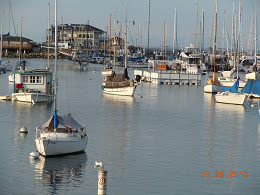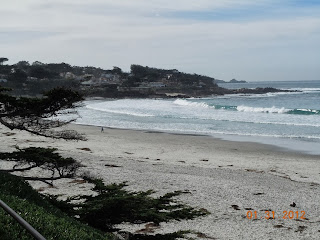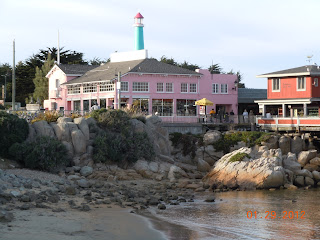 |
| Monterey Peninsula Coast |
Today, a vacation or weekend trip to Monterey brings thoughts of a beautiful bay, great seafood, the famous Cannery Row, the scenic Seventeen Mile Drive and, if you're a golfer, some of the finest golf courses in North America. Many people no doubt remember Cannery Row as being the namesake of one of the most popular novels written in America by Monterey County's famous author John Steinbeck. A very good side trip as part of your Monterey vacation is the Steinbeck Center located in nearby Salinas California.
The Monterey Shore and Marine Life
The Monterey Bay area is a natural marine sanctuary. The Monterey Bay National Marine Sanctuary is a Federally protected marine area offshore of California's central coast. The area stretches from Marin, just north of San Francisco proper, to Cambria. The shoreline length is 276 miles. According to the federal government, it is home to numerous mammals, seabirds, fishes, invertebrates and plants in a remarkably productive coastal environment. One of the more popular sites for both tourists and locals is the world renown Monterey Bay Aquarium. The Monterey aquarium attracts visitors from around the world.
Monterey and It's Whales
Monterey California is another excellent place to set out for a day of whale watching. Monterey California is actually one of the best whale watching sites on the entire west coast.
In some locales on the coast sightseerers often have to go a fair distance out to catch sight of the whales. Along the Monterey coast whales can often be seen offshore with the naked eye. One of the reason for this is that the area is home to the Monterey Submarine Canyon. This area is like the Grand Canyon undersea. It's the perfect habitat for many whale species and this underwater canyon allows them to come relatively close to shore.
For those wanting to go on whale watching excursions, there are several tour boats which depart Monterey harbor daily. When you're on your whale watching expedition there's also a good chance you'll see dolphins which are around Monterey Bay year around.
Another side note for music lovers. Jazz enthusiasts go by the thousands each year to the Monterey Jazz Festival held in September.The festival takes place at the fairgrounds and is a world renown event with top notch talent.
Monterey Was Settled By The Spanish
 |
| Monterey whale watching |
When the Spaniards were first exploring and then settling Alta California, Monterey was chosen as their seat of provincial government. In fact, the mission at Monterey which was then relocated to present day Carmel, was among the first three missions established by Father Junipero Serra in the province.
Monterey was the capital of Alta California from 1777 to 1849, first under the Spaniards and then under the government of Mexico.The presidio of Monterey was actually built there by Alta California's first governor as a defense against a suspected Russian invasion. The Russians had long been involved in the fur trade to the north above the San Francisco area. An invasion of course never occurred. The Russians came south to about 100 miles north of the Bay Area.
Monterey's Seafood Canning Industry
 |
| Monterey California harbor |
Historians generally place the origins of Monterey's large sardine industry with the opening of the F.E. Booth Company plant in the year 1902. Before coming to Monterey, Booth had operated a salmon canning plant in Pittsburg California just east of San Francisco. Soon afterwards, a man by the name of Knute Hovden arrived from Norway and teamed up with Booth and the areas canning industry really took off.
In 1904, an Italian fisherman named Pietro Ferrante arrived in Monterey and brought with him what is known as the "lampara net". According to the Aquarium of the Pacific, a lampara net "is a surrounding net with the center bagging part in the form of a spoon with two lateral wings making it possible to retain the school of fish when the two wings are hauled up at the same time". When Ferrante had arrived, the canning facilities were in place, the only problem was finding a way to have a steady supply of fish to can.
 |
| Monterey's Cannery Row |
By 1945 there was some nineteen plants operating. Monterey was truly the largest fishery center in the entire western hemisphere. The entire California west coast had a massive amount of canneries, over a hundred in total, that stretched from San Francisco all the way down to San Diego. This was a very large industry with thousands of workers. During the industry's peak year which was considered to be 1936-37, a total of 3 million cases of packed sardines were estimated to have been produced.
The Sardines Disappear
Sardines spawned off of Baja California and during the summer would travel from there all the way north to Alaska. In the fall and winter months they would return south to Baja. For Monterey, the peak sardine fishing season was in the fall. The fishing off the California coast appeared to have hit the peak in 1937 and then beginning in the 1940's and continuing through the 1950's, the annual catch began declining. The catch in the Pacific northwest was the first to collapse and then slowly down the coast the sardines just began to disappear. By the late 1950's the sardine had disappeared from southern California waters. What caused this? Was it over harvesting?
Marine biologists of course conducted many studies into the phenomena. By studying scale deposits off of southern California, the biologists suggested that there were some nine major sardine recoveries and collapses over about 1,700 years. They also determined that each of these cycles lasted about sixty years.
They also discovered that cold water ocean cycles favor anchovies and warm water cycles sardines. While over harvesting certainly can deplete supplies, the biologists found that sardines can simply disappear regardless. The various studies seem to point out that both sardines and anchovie supplies ebb and flow. They also indicate that at current, the sardine supply may very well be in the recovery stage.
 |
| Beach at Carmel CA |
They also discovered that cold water ocean cycles favor anchovies and warm water cycles sardines. While over harvesting certainly can deplete supplies, the biologists found that sardines can simply disappear regardless. The various studies seem to point out that both sardines and anchovie supplies ebb and flow. They also indicate that at current, the sardine supply may very well be in the recovery stage.
Visiting the Monterey Area
 |
| Monterey's Fisherman's Wharf |
A good number of people who travel to San Francisco include Monterey in their vacation planners. It's a beautiful part of the United States with a wide variety of both scenic and historic sites.
Driving down from the San Francisco Bay area, many people stop off at Mission San Juan Bautista. Another great visit of course is the town of Carmel California just to the south. Further south but an easy day trip there and back is Big Sur California with a coast line like no other.
If you happen love golf, then you'll find the Monterey area to be one of the finest golf venues in America. Monterey California is really a must vacation stop when on the west coast. Lodging in Monterey and Monterey dining can be found in all price ranges.
(Article and photos copyright Western Trips)

